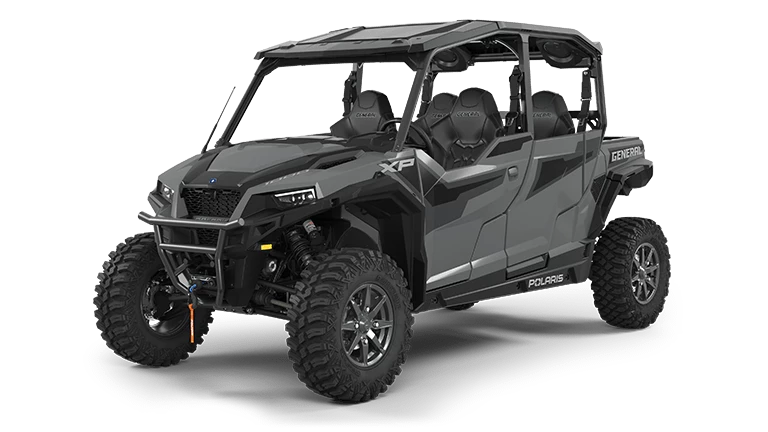As an Amazon Associate I may earn a commission from qualifying purchases at no additional cost to you.
Riders and mechanics often find themselves in need of effective diagnostic tools when maintaining or repairing ATVs and Side by Sides.
With advancements in technology, accessing and interpreting data from these vehicles has become more accessible and accurate.
Using specialized diagnostic tools can reveal critical information about the vehicle’s performance and potential issues, ensuring proper maintenance and timely repairs.

Understanding the right diagnostic techniques is crucial for anyone looking to keep their ATVs and Side by Sides in peak condition.
Whether it involves assessing engine performance, monitoring electronic systems, or evaluating mechanical parts, precision tools play a vital role in the diagnosis process.
Equipping oneself with knowledge of these tools aids in enhancing efficiency and reducing downtime.
For vehicle owners and enthusiasts, grasping the essentials of diagnostic tools not only simplifies troubleshooting but also enhances the longevity and performance of their machines.
This exploration into diagnostic processes can open up avenues for smarter maintenance practices and a better understanding of vehicle dynamics.
Overview of ATV and Side by Side Diagnostic Tools
In the world of ATV and side-by-side vehicles, diagnostic tools are vital for identifying mechanical and electrical issues. They provide insights into operational parameters, contributing to timely maintenance and repair.
Essential Features of Diagnostic Tools
Diagnostic tools must possess certain key features to be effective.
Compatibility is crucial; the tool should work seamlessly across a range of ATV and side-by-side models. A user-friendly interface ensures ease of use, allowing technicians to quickly access information without unnecessary complications.
Portability is also important, as technicians often need to use these tools in various settings. Data storage capabilities allow for analysis of past performance issues. These features combine to make diagnostic tasks streamlined and efficient.
Understanding Diagnostic Functions
Diagnostic tools perform a variety of functions essential for vehicle maintenance.
They can read and clear error codes, providing insight into any warning signals. The tools often feature real-time data monitoring, enabling continuous assessment of various vehicle parameters.
Advanced tools can also conduct component testing, helping identify specific areas in need of attention. This functionality supports technicians in diagnosing problems accurately, leading to more efficient repairs and maintenance efforts.
Common Diagnostic Tools for ATVs and Side by Sides
Several diagnostic tools are commonly used for ATV and side-by-side vehicles.
The OBD-II scanner is a staple, allowing for basic diagnostics and code reading. The CAN bus analyzer is another popular choice, providing detailed insights into the vehicle’s communication networks.
Some systems come with proprietary software designed by manufacturers for specific brand diagnostics. Handheld diagnostic devices that offer Bluetooth connectivity are also favored for their convenience and ease of use. Each tool serves distinct purposes, supporting varied diagnostic needs.
Navigating Diagnostic Software

Exploring diagnostic software involves understanding essential processes like performing upgrades, configuring vehicle parameters, and utilizing remote assistance features. These tools enhance the diagnosis and maintenance of ATVs and side by sides.
Software Upgrade and Maintenance
Regular software upgrades are crucial to maintain optimal performance in ATV and side-by-side diagnostic tools.
These upgrades often address potential vulnerabilities and improve functionality. Keeping the software updated ensures compatibility with new vehicle models and technological advancements.
For devices using platforms like Android 5.1.1 with an RK3128 quad-core processor, ensuring they have the latest updates maximizes processing efficiency and tool responsiveness.
Users should set up automatic updates or regularly check for manual updates to avoid missing important new features.
Vehicle Parameters and Custom Settings
Adjusting vehicle parameters and custom settings is essential for accurate diagnostics and personalized performance.
Software interfaces often allow users to access vehicle information and make the necessary tweaks directly from the user panel.
These settings may include adjusting engine parameters, vehicle speed, or other operational metrics. The software must be user-friendly, enabling users to easily interpret and modify complex data.
Proper configuration ensures the vehicle operates within intended parameters, prolonging its lifespan and performance.
Remote Assistance and Troubleshooting
Remote assistance features provide significant benefits for diagnosing issues that require expert intervention.
With connectivity features, technicians can remotely access the diagnostic software to assist with troubleshooting.
This functionality enables real-time interaction and issue resolution without needing physical presence.
Whether diagnosing engine issues or analyzing vehicle data, remote access facilitates efficient problem-solving. This capability is especially beneficial in remote locations where expert help is not readily available on-site, reducing downtime and associated costs.
Diagnostic Procedures and Techniques

Diagnostic tools are essential for maintaining and repairing ATVs and side by sides. Efficiently diagnosing issues requires a combination of standard procedures and advanced techniques to ensure accurate fault diagnosis and timely maintenance.
Standard Diagnostic Procedure
Standard diagnostic procedures typically start with connecting the diagnostic tool to the vehicle’s “diag socket”. This connection is crucial for accessing the vehicle’s electronic systems.
Once connected, automatic scanning can identify error codes. The technician can then use code reading to interpret these codes to pinpoint specific issues.
This step is important for identifying common problems within the vehicle’s engine, transmission, or other critical systems.
Identifying potential errors allows technicians to make informed decisions on repair strategies, saving time and resources.
Advanced Techniques in Fault Diagnosis
Advanced diagnostic techniques often utilize comprehensive scanning tools capable of intricate analysis. Technicians might rely on software that provides detailed data beyond basic error codes.
For instance, real-time monitoring of system performance can offer insights into issues that traditional diagnostic methods might miss. Some advanced tools also feature sophisticated fault diagnosis capabilities through enhanced algorithms.
These techniques are particularly useful when dealing with complex electronic systems or challenging intermittent faults. By employing such advanced methods, technicians can identify root causes with greater accuracy and efficiency.
Using Diagnostic Functions for Maintenance
Using diagnostic functions not only helps in identifying faults but is also essential for regular maintenance.
Many diagnostic tools offer preventive maintenance features. These functionalities can anticipate potential issues before they cause significant problems.
Regular diagnostic checks using these tools help ensure that the vehicle’s systems are operating within optimal ranges. They enable maintenance scheduling based on real-time data rather than fixed intervals.
Thus, diagnostic tools support both immediate repairs and long-term vehicle health, maximizing reliability and performance.
Calibrations and Adjustments
Calibrations and adjustments in ATVs and Side by Sides are crucial for optimal performance and longevity. This involves key tasks such as idle speed adjustment, CO adjustments, and A/F value resets to ensure engines run smoothly and efficiently.
Key Calibrations for ATVs and Side by Sides
Idle speed adjustment is essential for maintaining engine stability during idle. Keeping the RPM at the manufacturer’s specified range prevents stalling and rough idling. Technicians use diagnostic tools to measure and set the idle speed accurately.
CO adjustment is another crucial calibration. It involves adjusting the carbon monoxide levels in the exhaust to reduce emissions. This adjustment is vital for meeting environmental regulations and ensuring efficient fuel combustion.
Resetting the A/F (Air/Fuel) values is also important. It ensures the correct air-to-fuel ratio, impacting both engine performance and fuel efficiency. This reset is often done after significant engine work or component replacement to maintain optimal engine performance.
Fine-Tuning and Adjustments
Fine-tuning involves making precise adjustments to meet specific performance needs of the vehicle. This might include tweaking suspension settings for better handling on various terrains.
Such adjustments require an understanding of the vehicle’s mechanical systems and the conditions it will face.
In addition to mechanical adjustments, electronic tuning through ECU (Engine Control Unit) recalibration is common. It helps fine-tune engine parameters for improved performance and responsiveness.
This might involve remapping the ECU software to suit specific riding styles or enhance fuel efficiency.
Regular diagnostic checks guide these adjustments by identifying areas needing improvement. Following the manufacturer’s guidelines ensures adjustments enhance performance without risking mechanical failure. Employing modern diagnostic tools ensures accurate and efficient fine-tuning.
Error Codes and Fault Guidance
Understanding error codes and providing effective fault guidance are essential components in diagnosing ATV and Side by Side vehicle issues. Recognizing error code patterns and implementing corrective measures expedite repairs and ensure optimal performance.
Interpreting Error Codes
Error codes serve as a crucial diagnostic tool by specifying issues within the vehicle’s systems. Each code typically consists of a letter identifying the system, followed by numbers pinpointing the fault’s nature. Technicians rely on service manuals or specialized diagnostic tools to reference these codes.
For instance, a common error code like P0301 indicates a misfire in the first cylinder.
Accessing these codes often requires an OBD-II scanner, commonly used to connect to the vehicle’s onboard diagnostics. Understanding these codes accurately facilitates precise troubleshooting and reduces guesswork during repairs.
Follow-up Actions and Fault Guidance
After identifying the error code, implementing appropriate follow-up actions is critical in rectifying issues.
Fault guidance involves systematically addressing potential causes of the error. For example, if a sensor failure is detected, technicians may perform tests or replace faulty components.
Recommended Actions:
- Consult a repair manual for specific troubleshooting steps.
- Conduct detailed inspections of relevant parts.
- Use testing equipment to verify operational integrity.
Technicians benefit from maintaining an organized approach when managing these faults, ensuring all sources of error are considered. Proper diagnostics minimize downtime and ensure effective restoration of vehicle functionality.
Specific Vehicle Brand Diagnostics
Diagnostic tools for all-terrain vehicles (ATVs) and side-by-sides vary significantly between brands such as Polaris, Can-Am, and Indian. Each brand offers unique systems and tools designed to optimize the performance and maintenance of their vehicles.
Polaris Diagnostics
Polaris vehicles require advanced diagnostic tools tailored to their proprietary systems.
Tools like the Digital Wrench by Polaris offer comprehensive diagnostic capabilities, enabling identification and resolution of various issues related to the engine, transmission, and electrical components.
Digital Wrench allows technicians to retrieve and interpret error codes, perform software updates, and adjust engine parameters efficiently. It also offers a user-friendly interface, which is essential for both seasoned mechanics and novices aiming to maintain their Polaris vehicles.
Can-Am and BRP Diagnostics
BRP’s Can-Am division utilizes specialized tools ensuring precise diagnostics.
The B.U.D.S. (BRP Utility/Diagnostic Software) is key in assessing engine and system performance, calibrating components, and conducting firmware upgrades.
B.U.D.S. is indispensable for technicians working on complex electronic control systems in Can-Am vehicles. It provides a seamless diagnostic experience, with functionalities such as data logging and fault code analysis that aid in preemptive maintenance and immediate troubleshooting.
Indian and Victory Diagnostics
Indian and Victory motorcycles use distinct diagnostic systems given their specific engineering. Digital Technician II is widely favored for its effective diagnosis of electronic and mechanical systems. This tool facilitates access to engine fault codes, offering insights into the bike’s performance and necessary maintenance actions.
Notably, Digital Technician II supports service technicians with guided tutorials and real-time data monitoring. It ensures timely and accurate troubleshooting for Indian and Victory motorcycles.
Its intuitive design helps maintain peak vehicle performance by simplifying complex diagnostic tasks.
Aftermarket Diagnostic Tools
Aftermarket diagnostic tools provide efficient solutions for technicians and enthusiasts, offering compatibility with a range of vehicles, including motorcycles and ATVs. They enable access to real-time data monitoring and often come with comprehensive after-sale services.
OBDSTAR MS70 for Motorcycles and ATVs
The OBDSTAR MS70 is a specialized diagnostic tool designed for motorcycles and ATVs. It provides extensive support for multiple systems, enabling users to perform complete diagnostics on various vehicle brands.
The compatibility spectrum of the MS70 is broad, allowing it to work seamlessly with numerous motorcycle models.
One of the standout features of the MS70 is its ability to monitor real-time data efficiently. This tool helps users track performance metrics and identify potential issues quickly.
Moreover, the MS70 is part of the OBDSTAR MOTOSTAR series, known for its reliable performance and user-friendly interface.
After-sale service support is strong, ensuring users have access to necessary updates and technical assistance when needed. This makes the MS70 a valuable asset for both individual users and professional technicians handling multiple vehicles.
Technical Support and Resources
Effective technical support is crucial for maintaining ATV and Side by Side vehicles. Access to technical bulletins and an understanding of shipping methods and service options can significantly impact maintenance outcomes.
Accessing Technical Bulletins
Technical bulletins provide detailed information on common issues, updates, and troubleshooting for ATV and Side by Side vehicles. They are essential for identifying and resolving potential problems quickly and efficiently.
Technicians and users can access these documents through manufacturer websites or authorized dealer portals. Some manufacturers offer subscriptions to regularly receive bulletins via email, ensuring that users stay informed about the latest developments.
By consulting these documents, technicians can avoid common pitfalls and apply the most up-to-date repair methods.
Understanding Shipping Methods and Service Options
Shipping methods and service options can strongly influence the maintenance and repair process for ATVs and Side by Sides.
Reliable shipping ensures that parts arrive on time and in good condition. Manufacturers often provide shipping guides, outlining the most effective ways to handle sensitive components.
It is important to choose the right service option, such as express or standard, depending on the urgency of the repair.
After-sale Service offered by the manufacturer or dealer can further guarantee efficient maintenance. This includes warranty services and technical support hotlines to assist with troubleshooting. Understanding these resources helps ensure that vehicles are repaired promptly and correctly the first time.
Equipment and Accessories
When diagnosing ATVs and Side by Sides, certain equipment and accessories can greatly improve the efficiency and accuracy of the diagnostic process. Understanding the hardware features and connection options can help technicians select the right tools for the job.
Diagnostic Tool Hardware Features
Modern diagnostic tools often come equipped with advanced hardware features that enhance usability and effectiveness.
Many devices now feature a capacitive touch screen, providing a responsive and intuitive interface. This allows users to easily navigate diagnostic menus and options with precision.
Tools equipped with VIN recognition technology can automatically identify vehicles, saving time and ensuring accuracy.
The incorporation of tire pressure monitoring systems offers real-time data, crucial for both safety and performance checks.
Some devices also support wi-fi connections, facilitating software updates and remote access to diagnostic information.
Together, these features empower technicians to perform thorough and informed evaluations of ATVs and Side by Sides.
Connection and Compatibility Accessories
Compatibility and connection accessories play a significant role in the functionality of diagnostic tools.
Diag sockets are essential for connecting diagnostic equipment to the vehicle’s system, and it’s important that the tool supports a variety of socket types to accommodate different vehicle models.
Having a range of adapter cables can also enhance compatibility with older or less common vehicle systems.
For wireless connectivity, bluetooth and wi-fi-enabled devices allow for seamless data transmission and remote operations. These accessories ensure that tools remain flexible and versatile in various diagnostic scenarios, enabling technicians to maintain efficiency and effectiveness across a wide range of vehicles.
Programming and Vehicle Communication Systems
Programming and vehicle communication systems play a crucial role in diagnostic procedures for ATVs and Side by Sides. These systems ensure precise control and synchronization, enhancing real-time data flow and accuracy.
Control Module Programming and Adaptation
Control module programming involves updating or reconfiguring a vehicle’s electronic control units (ECUs) to improve performance or fix faults. Technicians use specialized software to interact with the ECUs.
This requires VIN recognition for accurate module identification. This process ensures compatibility and updates tailored to specific models.
Module adaptation adjusts settings and integrates new components, ensuring all systems communicate seamlessly. This approach enhances performance and resolves malfunctions effectively.
Adaptation is key for integrating aftermarket parts, maintaining system harmony.
Communication Protocols and Data Exchange
Communication protocols underpin data exchange between diagnostic tools and vehicle systems.
Common protocols like OBD-II, CAN, and J1939 facilitate real-time data flow and accurate fault detection. These protocols standardize vehicle-to-tool communication.
This allows technicians to retrieve, interpret, and address fault codes efficiently.
Effective data exchange supports vehicle communication systems, ensuring that diagnostics are precise and actions taken are valid. Understanding these protocols means technicians can diagnose issues swiftly, minimizing vehicle downtime.
Diagnostics for Luxury Motorbikes and Side by Sides
Diagnosing luxury motorbikes and side by sides requires a keen attention to detail and an understanding of the advanced technology embedded in these vehicles. Specialized tools often accompany these high-end models to meet their specific diagnostic requirements.
Specialized Diagnostic Requirements
Luxury motorbikes and side by sides are often equipped with sophisticated electronic systems. They may include advanced traction control, customizable ride modes, and electronic stability control.
To effectively diagnose issues, technicians may require specialized diagnostic tools capable of interfacing with the manufacturer’s proprietary systems.
Using these specialized diagnostic tools, technicians can access essential data, including engine performance metrics and fault codes. This enables accurate identification of issues and potential optimization of vehicle performance.
The precision of these tools is crucial for ensuring that the complex electronic systems function as intended.
Features Specific to Luxury Brands and Models
Luxury models often feature customized and high-performance components. The onboard systems may include high-resolution displays and premium audio systems.
Diagnostics for these features typically require advanced software capable of interpreting the unique data output of luxury vehicles.
Additionally, the diagnostic process for luxury motorbikes and side by sides often involves software updates and system recalibrations. Such updates ensure models maintain peak performance levels and integrate the latest technological advancements.
Overall, working with these exclusive models demands a high degree of technical knowledge and access to brand-specific diagnostic equipment.
International Support and Language Options
ATV and Side by Side diagnostic tools cater to a global market with features like multilingual support and compatibility with various international vehicle brands. This ensures users can efficiently maintain and repair vehicles regardless of geographic location or language barriers.
Support for Global Vehicle Brands
Diagnostic tools for ATVs and Side by Sides are essential for maintaining different global vehicle brands. Polaris, Honda, Can-Am, and Yamaha are some leading names requiring comprehensive diagnostic coverage.
Each brand has unique software protocols, necessitating tools that can adapt to these variations.
Manufacturers are increasingly offering updates to support these popular global brands. For instance, diagnostic tools can access vehicle-specific data quickly and offer features such as troubleshooting systems and checking compatibility. This adaptability maintains efficient operations regardless of location.
Key Points:
- Wide brand coverage including Polaris, Honda, Can-Am, and Yamaha.
- Regular updates and software protocols to ensure compatibility.
- Efficient access to vehicle-specific data for troubleshooting.
Diagnostic Tools with Multilingual Support
Diagnostic tools must feature multilingual support to accommodate users from different regions, such as Russian, Spanish, and others.
This functionality allows technicians worldwide to navigate diagnostic interfaces effectively and understand error codes and troubleshooting steps in their native language.
The inclusion of multilingual capabilities involves collaborative efforts with linguists to translate complex technical documentation.
Tools with intuitive language-switching capabilities improve accuracy by reducing misunderstandings during maintenance.
Offering comprehensive support material, such as manuals and online resources, in multiple languages further assists global users in troubleshooting issues efficiently.
Key Points:
- Supports languages like Russian and Spanish.
- Collaboration with linguists for accurate translations.
- Availability of manuals and resources in multiple languages.








